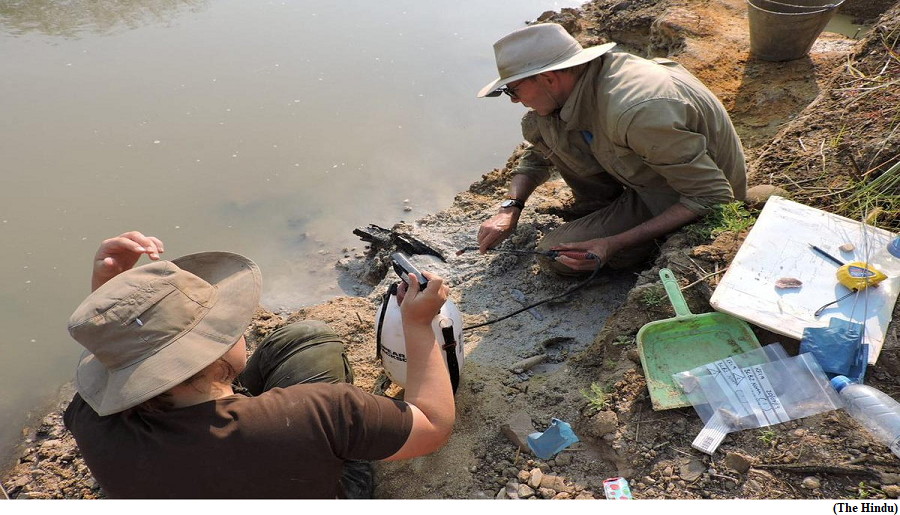Eight institutes give an array of reasons for Joshimath sinking (GS Paper 3, Environment)

Why in news?
- Separate studies conducted by eight premier institutions of India to know the cause of land subsidence in Joshimath town of Uttarakhand attributed seismic activities, construction loopholes, population pressure, poor drainage system and others as the ‘likely’ reason for the sinking of the Himalayan town.
- With every study conducted with a different approach, these reports reaffirmed the sensitivity of the area but nothing concrete has come out on what exactly went wrong in January.
Central Building Research Institute (CBRI) report
- In its report, the CBRI stated that Joshimath town has 44%, 42%, 14% of masonry, RCC and other (traditional, hybrid) construction typologies, respectively, among which 99% are non-engineered. It means they are not in compliance with the National Building Code of India, 2016.
- Joshimath town is situated on Vaikrita groups of rocks overlain by morainic deposits which are composed of irregular boulders and clay of varying thicknesses. Such deposits are less cohesive and susceptible to slow subsidence and landslide subsidence.
- There is a history of creeping and occasional subsidence in the region and what happened in December 2022-January 2023 was another such event.
National Institute of Hydrology (NIH):
- The Roorkee-based NIH, said that maps of various springs, drainage network and areas of subsidence infer that land subsidence and subsurface water in Joshimath might have some connections.
- The isotopic and water quality signature of the samples taken from NTPC sites differs from the JP site as well as drains and springs in the nearby area of Joshimath.
- The bacteriological analysis also suggested that the gush water is fresh water and not contaminated by the local drains, giving a clean chit to the NTPC whose construction activities were being dubbed as one of the biggest reason for land subsidence.
- The institution hence recommended the safe disposal of the water coming from the upper reaches and waste disposal as the top priority.
Wadia Institute of Himalayan Geology (WIHG):
- The WIHG mentioned earthquakes as a reason for slow and gradual land subsidence.
- The main reason for the subsidence appears to be internal erosion caused by the subsurface drainage, which may be due to infiltration of rainwater/melting of ice/wastewater discharge from household and hotels.
- Though subsidence is continuous phenomenon, it can be minimised by controlling infiltration of water, which helps in minimising the internal erosion.
ISRO:
- After an analysis by the Small BAseline Subset Interferometry SAR Technique, the ISRO stated that the subsidence in the Joshimath region may be due to toe-cutting phenomenon, slope instability as a result of seepage of local drainage water in the soil, terrain and edaphic characteristics, loose and unconsolidated moraine materials of the slope (due to old landslide) and flash flood events in and around the area in the recent past.
- This has resulted in development of cracks in the ground as well as houses in Joshimath town.
Conclusion:
- In 2012 after the Ukhimath disaster, there was a clear recommendation by the State Disaster Management Department to stop blasting in the vicinity of Joshimath. The report had asked to regulate infrastructure development.
- Geologist termed the reports of the eight institutions ‘old wine in a new bottle’. These reports clearly said all that had been said 46 years ago in the M.C. Mishra Committee report.
Humans have built with wood for 4.7L years
(GS Paper 3, Science and Technology)
Why in news?
- Along the banks of the Kalambo River in Zambia near Africa’s second-highest waterfall, archaeologists have excavated two logs of the large-fruited bushwillow tree that were notched, shaped and joined nearly half a million years ago.

Details:
- These artefacts represent the oldest-known example of humans, building wooden structures, a milestone in technological achievement that indicates that our forerunners displayed more ingenuity than previously thought.
- The overlying log at Kalambo Falls is about 1.4 metres long, with tapering ends. About 1.5 metres of the underlying log was excavated.
- The wood, found in a waterlogged condition, was preserved by a permanent high-water table at the site. Clay sediments surrounding it provided an oxygen-free environment preventing decay.
Key Highlights:
- The logs, modified using stone tools, appear to have been part of a framework for a structure, a conclusion that contradicts the notion humans at that time simply roamed the landscape hunting and gathering resources.
- The framework could have supported a walkway or platform raised above the seasonally wet surroundings. A platform could have multiple purposes including storage of firewood, tools, food and as a foundation on which to place a hut.
- While the vast majority of archaeological sites of this age preserve only the stone tools, Kalambo Falls provides us a unique insight into the wooden objects that these tools were being used to create, allowing a much richer and more complete picture of the lives of these people.
Homo heidelbergensis:
- The earliest-known Homo sapiens fossils date from roughly 300,000 years ago in Morocco. The Kalambo Falls logs were determined to be from about 476,000 years ago.
- No human remains were found there, but Barham suspects the artefacts were fashioned by a species called Homo heidelbergensis known from about 700,000 to 200,000 years ago.
- Homo heidelbergensis possessed a large brow ridge and a bigger braincase and flatter face than earlier hominins - species on the human evolutionary lineage.
Bihar govt announces new scheme for unemployed minority community youths
(GS Paper 2, Social Justice)
Why in news?
- The Bihar government recently launched 'Mukhyamantri Alpsankhyak Udyami Yojna'(MAUY) for unemployed youths from the minority community.
- It was launched with an aim to promote industrial development and generate employment among unemployed minority youths.
Implementation:
- The scheme will be implemented on almost similar lines of the existing Mukhyamantri SC/ST/EBC Udyami Yojana, Mukhyamantri Mahila Udyami Yojna (MMUY) and the Mukhyamantri Yuva Udyami Yojana (MYUY).
- Under this scheme, the Bihar government will provide Rs 10 lakh to an unemployed minority woman or man to start a new industry. Of Rs 10 lakh, Rs 5 lakh would be subsidy, while the rest would be loan, to be returned in installments.
Free treatment:
- The cabinet also decided to make medical tests and treatment at the Indira Gandhi Institute of Medical Sciences (IGIMS, Patna), one of the main healthcare institutions in Bihar, free.
- Except registration and bed charges, everything will be free for patients at IGIMS.
Traffic police stations:
- The cabinet also approved the proposal of the state home department to create 28 dedicated traffic police stations across Bihar, in addition to the existing 12.
- Traffic police stations will be set up in 23 towns that have a population of over 2 lakh, besides five in small towns.
- These new traffic police stations will come up in Kishanganj, Nawada, Siwan, Buxar, Madhubani, Jehanabad, Bhabhua, Supal, Saharsa, Jamui, Rohtas, Betiah, Vaishali, Aurangabad, Araria, etc. The cabinet also approved changes in the jurisdiction of existing traffic police stations of Patna and Gaya.
- Currently, traffic police stations are operational in 12 districts Patna, Bhagalpur, Gaya, Muzaffarpur, Nalanda, Purnia, Saran, Darbhanga, Ara, Begusarai, Katihar and Munger.





